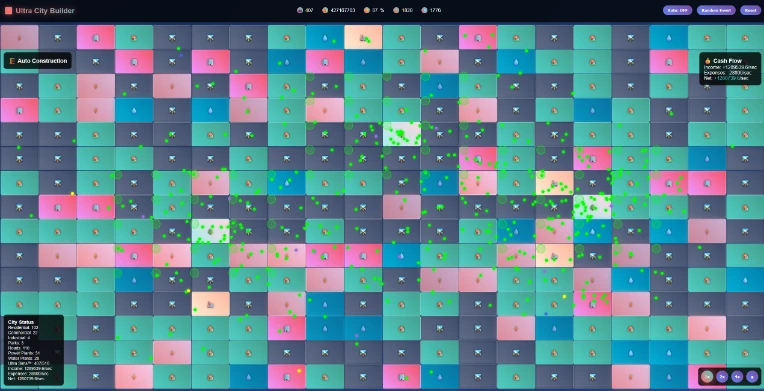Core Architecture:
The Ultra City Builder represents a sophisticated browser-based city simulation built entirely in vanilla HTML, CSS, and JavaScript. The codebase demonstrates several advanced programming patterns and game development techniques worth examining.
Key Systems & Capabilities:
Autonomous AI City Management
• Auto-expansion algorithm: Analyzes city needs in real-time and prioritizes construction based on population, resource availability, and infrastructure gaps
• Intelligent building queue: Constructs buildings with visual progress tracking and resource validation
• Dynamic need assessment: Evaluates power-to-population ratios, residential capacity utilization, and happiness metrics to determine optimal growth patterns
Advanced Sim Behavioral AI
The SimAI class implements sophisticated citizen behaviors:
• State-based decision making: Sims transition between wandering, working, shopping, and relaxing states
• Pathfinding and targeting: Citizens navigate toward residential, commercial, and recreational areas
• Happiness-driven emigration: Unhappy sims can leave the city, creating feedback loops
• Special "coder" sims: 10% of citizens possess coding knowledge and can autonomously build parks when conditions are met
Dynamic Economic Modeling
• Multi-layered income streams: Residential, commercial, and industrial buildings generate different revenue types
• Population-threshold mechanics: Water facilities become profitable only after reaching 100 citizens
• Real-time expense tracking: Building maintenance costs scale with city size
• Visual profit indicators: Animated money indicators appear on profitable water facilities
Environmental Systems
The weather system creates immersive atmospheric effects:
• Procedural weather generation: Rain and snow effects with randomized timing
• Gameplay impact: Weather affects citizen happiness and city mood
• CSS-based particle systems: Efficient rain drops and snowflakes using pure CSS animations
Disaster Framework
• Probabilistic disaster events: Earthquakes, tornadoes, and fires with realistic spread mechanics
• Building damage algorithms: Disasters can partially or completely destroy infrastructure
• Fire propagation: Fires spread to adjacent buildings with decreasing intensity
Resource Management Complexity
• Multi-dependency systems: Buildings require specific resources (power for residential, water for parks)
• Cascading effects: Resource shortages prevent construction and affect citizen happiness
• Infrastructure scaling: Power and water production must scale with city growth
Technical Implementation Highlights:
Performance Optimizations
• Efficient grid rendering: 20x15 cell grid using CSS Grid with minimal DOM manipulation
• Selective updates: Only modified elements are re-rendered during game loops
• Controlled animation timing: Uses requestAnimationFrame for smooth 60fps performance
Visual Design Architecture
• Gradient-based aesthetics: Extensive use of CSS linear gradients for modern visual appeal
• Particle effect systems: Rain, snow, and profit indicators using CSS animations
• Responsive hover states: Buildings and UI elements provide visual feedback
Code Organization
The codebase demonstrates solid object-oriented principles:
• Modular system design: Weather, disaster, and AI systems are separate classes
• Event-driven architecture: Click handlers and game loops operate independently
• State management: Game state is centralized in the main UltraCity class
Limitations and Technical Debt
Scalability Concerns
• Hard-coded grid dimensions: 20x15 grid is not easily configurable
• Linear search algorithms: Building searches use O(n²) iterations across the grid
• Memory management: Sims and visual effects accumulate without cleanup mechanisms
Browser Dependencies
• No persistence layer: Game state resets on page refresh
• Single-threaded execution: All simulation logic runs on the main thread
• CSS-dependent animations: Weather effects rely heavily on browser CSS animation support
Innovation Points:
Hybrid Automation Model
The game allows both manual building placement and autonomous AI expansion, creating a unique hybrid gameplay experience where players can intervene in or observe algorithmic city growth.
Economic Feedback Loops
The water profitability mechanic creates interesting economic dynamics where infrastructure investments become profitable only after reaching critical population mass.
Emergent Behavior Systems
The combination of sim AI, weather effects, and disaster systems can create unexpected emergent scenarios where multiple systems interact in complex ways.
Source Code Access:
The Ultra City Builder showcases how modern web technologies can create sophisticated simulation experiences without requiring external frameworks or plugins. The codebase represents a solid foundation for browser-based city simulation games, though production deployment would benefit from addressing the scalability and persistence limitations identified above.

